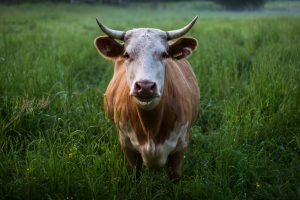Photo from Adam Morse.
Summary written by Czeslaw Radziejewski, Ph.D.
Antibody Engineering & Therapeutics, held in December 2022, offered many opportunities to hear exciting and informative presentations by experts in the field, including Vaughn Smider, Ph.D., President, Applied Biomedical Science Institute, who discussed ultralong CDR H3-based knobs as the smallest antibody fragment and Jeff Allen, Ph.D. Vice President, Protein Sciences, Pelican Expression Technology, who discussed Large-scale production of knob peptides.
In 1997 Osvaldo Lopez and his colleagues [1] at the University of Nebraska analyzed transcripts encoding the variable regions of immunoglobulin heavy chains from adult and fetal bovine splenocytes. They were the first to notice the presence of long heavy chain CDR3s. The bovine CDR3s ranged in length from 13 to 28 amino acids, with the average length of CDR H3 being 21 residues in both adults and fetuses. This was longer than had been previously reported for other mammals. In a subset of bovine antibodies, CDR H3s are ultralong (50-70 AA).[2] The structure of ultralong CDR H3s was solved by Wang et al. [2] and the results demonstrated that ultralong CDR H3s all adopt similar architectures, with each composed of a long protruding beta-ribbon “stalk” and diverse disulfide-bonded “knob” (PDB: 4K3D). Up to six cysteine residues can be found in sequences of bovine CDR H3, all involved in disulfide bridges. The loops within the knob domain are thought to be involved in antigen binding. This contrasts with human antibodies where the antigen binding surface is formed from six CDR loops. Bovine CDR H3s are enormously diverse, and the diversity is generated by somatic hypermutation. [3] There is little diversity in CDR H1 and CDR H2, and cows use one light chain. Cows are not unique in having antibodies characterized by long CDR H3s. Other animals with these antibodies include zebu, yak, American and European bison.
It was previously observed that some broadly neutralizing antibodies against HIV also have longer CDR3s. Sok et al. [4] showed that immunization in cows could elicit rapid generation of neutralizing anti-HIV antibodies. Using x-ray crystallography, cryo-electron microscopy, and site-directed mutagenesis, Stanfield et al. [5] elucidated the structure of one monoclonal antibody elicited in cows by immunization with the HIV envelope trimer and showed molecular details of the knob mini-domain binding to a cryptic site on the gp120 CD4 receptor.
Knob domains are reasonably similar in size and shape to cyclotides/knottins, such as prototypic Cyclotide Kalata B1 and other disulfide-bonded peptides. Clinical applications for T cell immunotherapies are now emerging for analogs of cyclotides, for example, inhibition of the Kv1.3 channel. The Kv1.3 potassium channel is expressed abundantly on activated T cells and mediates the cellular immune responses. Sea anemone ShK cyclotide peptide was grafted into the β-ribbon ‘stalk’ of the ultralong CDR H3 scaffold of a humanized bovine IgG and showed the ability to block the Kv1.3. [6] The analog of the ShK peptide called ShK-186 or dalazatide blocks this channel, suppresses T-cell activation and is in human trials as a therapeutic for autoimmune disease.


